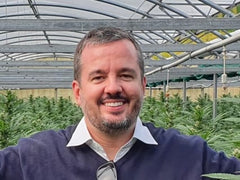The versatile nature of hemp makes it one of the oldest cultivated plants, covering at least several thousand years of history. Its seeds, fibres, and oils have long been applied in textiles, ropes, industrial processes, and various formulations.
In many ancient cultures, hemp was valued for its strength, durability, ease of cultivation, and its ability to thrive across a range of climates. This adaptability made it a prominent crop across societies, often supporting local economies and day-to-day life.
Throughout my career of more than a decade in the hemp industry, I have observed the growing recognition of hemp’s practical value. Working within CBD and hemp production has given me a detailed view of how this plant continues to be relevant in both historical and present contexts.
As hemp was introduced to different regions, its uses broadened, impacting agricultural methods and trade. Although it shares botanical characteristics with cannabis, hemp is distinguished by its notably low THC content, which separates it from psychoactive strains.
Hemp’s importance has shifted over time in response to political and social changes, but its value has remained consistent in areas where its capabilities have been recognised and utilised.
Save up to 30% when you order your CBD oil today
Key takeaways
- Exploring the deep historical and cultural relevance of hemp across civilisations.
- A timeline of key moments in hemp’s development and integration into society.
- Understanding hemp’s present and future applications through the lens of its past.
- Recognising how hemp continues to contribute to modern sustainable practices.
This article is provided for informational purposes only and does not relate to any of the products available in our webshop. For more information, please see our full disclaimer.
The ancient origins of hemp cultivation
Hemp has been cultivated and used by various civilisations for thousands of years. It has long been valued for its versatility and ease of growth, especially in ancient Asia and Europe.
Archaeological evidence indicates that hemp was among the earliest plants domesticated for fibre, used to make textiles, ropes, and essential utilitarian goods.

Early use in Asia and the Middle East
In Asia, particularly China, records dating back to 2800 BCE show that hemp was a key agricultural product. It was used in a variety of daily tools, clothing, and ceremonies. In the Middle East, hemp was similarly valued for its strong fibre and practical applications in food and materials.
Migration of hemp cultivation to Europe
Through trade routes, hemp cultivation spread to Europe, where it was quickly adopted by civilisations such as Greece and Rome. These societies used hemp for fabric production, maritime equipment, and early medicinal practices. Its adaptability made it widely accepted and integrated into many aspects of life.
Hemp's spread across continents contributed to cultural and technological exchanges. Studying its early usage reveals the influence of plants on global development. Hemp's resilience and utility helped shape infrastructure, economy, and trade in historical societies.
Hemp's role in maritime endeavours
Hemp played a fundamental role in the maritime industries of the past, particularly in naval operations. Its robust qualities were essential for enduring harsh marine environments and supporting logistics at sea.
Its primary functions included providing durable rope and sail materials. Hemp fibres were resistant to saltwater and abrasion, making them ideal for long-term marine use. This reduced the need for frequent replacement and aligned with early sustainability practices.
- Hemp ropes and sails were standard on naval and commercial ships.
- Its resistance to salt and moisture made it a preferred material at sea.
- Hemp caulking was used to waterproof wooden hulls.
- Hemp oil served to preserve wood and was also used in lighting.
The demand for hemp in maritime trade also encouraged cultivation and processing industries on land, supporting employment and shipbuilding economies. This relationship between agriculture and naval innovation demonstrates hemp’s influence beyond the farm.

Below is a summary of hemp’s key maritime applications:
| Maritime application | Function | Benefit |
|---|---|---|
| Ropes and sails | Essential for ship operation | Resilient to salt, wind, and wear |
| Caulking | Seals and waterproofs wooden ships | Prevents water damage and extends lifespan |
| Hemp oil | Preserves wood and fuels lamps | Protects materials and provides utility lighting |
The history of using hemp products in naval work shows their value. They contributed to maritime industries and reflected early environmental thinking. This legacy invites renewed interest in how hemp can be applied today.
Hemp’s historic place in shipbuilding and exploration highlights its importance in durable design and resource efficiency. Its resilience under harsh conditions supports its relevance in sustainability efforts.
What are the most common uses of hemp products?
Hemp in agriculture
Hemp’s reintroduction into modern farming marks the return of an ancient crop with updated relevance. New agricultural policies increasingly view hemp as a strategic crop for sustainable production.
Fibre production for textiles
Hemp’s bast fibres are used in textiles ranging from ropes to fine fabrics. These fibres are valued for their strength and renewability. Cultivation requires fewer chemical inputs compared to conventional fibre crops, making it a preferred option for environmentally responsible farming.

Hemp seeds and oil in nutrition
Hemp seeds and hemp oil are recognised for their natural content of omega-3 and omega-6 fatty acids, as well as their plant-based protein profile. These attributes make them suitable for use in diverse dietary formulations.
Hemp grown for seed and oil supports multiple sectors and aligns with trends in sustainable agriculture and plant-based food sourcing.
Its modern use in farming illustrates how hemp continues to bridge heritage with innovation—through fibre, seed, and environmentally conscious crop planning.
Order and enjoy up to 30% off your CBD oil purchase
Historical significance of hemp in industry
Hemp has supported industry for millennia—from ropes and sails to paper and textiles. Its longstanding applications demonstrate its versatility and durability across civilisations.
Dating back 10,000 to 12,000 years, hemp is among the earliest cultivated plants used for fibre. This ancient use laid the groundwork for innovations in textiles, construction, and information sharing.
- Ancient textile makers used hemp for its strength and natural resilience.
- Hemp ropes and sails were essential for long-distance maritime trade.
- Hemp paper revolutionised communication in early Chinese society.
Today, hemp continues to be used in new ways—such as in bio-based plastics and green construction materials—offering alternatives with a reduced carbon footprint.
| Period | Industrial use | Impact |
|---|---|---|
| Ancient civilisations | Textiles, ropes | Supported early trade and technological development |
| 17th–18th century | Maritime applications | Enabled durable and reliable naval equipment |
| Modern era | Sustainable products | Supports low-impact alternatives in manufacturing |
Hemp’s industrial value continues to grow. Its long-standing presence in manufacturing offers lessons in how renewable materials can serve both historical and contemporary needs.
The golden age of hemp
Before industrialisation, hemp was a cornerstone of everyday life in many communities. Its practical qualities contributed to construction, textiles, and social infrastructure.
Hemp in crafting and construction
In crafting and construction, hemp fibres were used for ropes, cloth, and a material known as hempcrete—an early composite known for its insulating properties and reduced environmental impact.
Hempcrete was particularly valued in architecture for its lightweight and breathable characteristics, contributing to the longevity of traditional buildings.

The cultural impact of hemp products
Hemp also carried cultural weight—featured in crafts, home décor, and community rituals. Its widespread use symbolised self-reliance, local craftsmanship, and natural living.
Historically, hemp was appreciated not only for its utility but for what it represented: resilience, practicality, and sustainable use of resources. These values remain relevant as societies seek alternatives to more resource-intensive materials.
Today’s renewed interest in hemp builds on these traditions, showing how the past can guide environmentally mindful decision-making in both industry and daily life.
| Product | Use in pre-industrial era | Contemporary use |
|---|---|---|
| Hemp fibres | Ropes, textiles | Eco-friendly clothing |
| Hempcrete | Construction material | Sustainable building projects |
| Hemp seeds | Nutrition | Plant-based oils and food products |
Today, as heritage and sustainability meet, hemp's golden age inspires modern innovation in natural materials. Learning from hemp's past allows us to honour its history and contribute to a more resource-efficient future.
Major milestones and developments
Reviewing the key milestones in the hemp sector offers valuable perspective on its periods of growth, decline, and renewed interest. This timeline highlights hemp's journey from a vital agricultural resource to a restricted plant, and now, its re-emergence in global markets.
Traditionally valued for its fibres in Asia, hemp became widely used in textiles and rope-making. Its enduring versatility established it as a practical material across multiple industries.
- During the Renaissance, demand for hemp rose significantly due to its essential role in manufacturing sails and ropes for European maritime ventures.
- In the 17th and 18th centuries, hemp cultivation became widespread in the Americas, supported by colonial authorities encouraging its agricultural production.
- The 20th century marked a decline in hemp activity following measures that limited its cultivation and trade in the United States.
In recent years, hemp has been reintroduced into mainstream agriculture, paving the way for further research and commercial opportunities.
This renewed focus is also visible in economic investments, with companies advancing production methods and promoting sustainable solutions. Despite existing challenges, hemp’s versatility continues to demonstrate its value across evolving market dynamics.
The progression of hemp showcases its ongoing importance as a sustainable material with diverse practical uses over time.
Order CBD oil now and save as much as 30%
Industrial uses of hemp
Hemp has transformed from a traditional agricultural product to a versatile input in numerous modern industries, ranging from papermaking to automotive parts. These applications highlight hemp's capacity to support innovation and sustainability.
Revolutionising the paper industry
The use of hemp in papermaking is gaining attention for its environmental advantages. Hemp paper production generally requires fewer chemicals and less water, and it offers superior recyclability compared to wood-based alternatives.
Innovation in automotive and construction materials
Hemp is also impacting industries such as automotive manufacturing and construction. For example, the automotive sector has integrated hemp composites to make components lighter, stronger, and more eco-conscious. In construction, hempcrete is being embraced for its thermal properties and energy efficiency.
These developments demonstrate how hemp is supporting progress toward lower-impact production across sectors. Its versatility in industrial applications reflects both historical reliability and forward-looking potential.
Stigma and the historical decline of hemp
Over time, hemp's reputation has been shaped by a combination of social, political, and economic factors. Once regarded as a valuable agricultural resource, its status diminished due to its association with high-THC cannabis varieties.
In the 20th century, particularly within the United States, restrictive measures played a key role in hemp’s decline. Public misconceptions and broad classifications that linked hemp with psychoactive cannabis often influenced these developments.

Contemporary perspectives and industry opportunities
In recent years, shifts in how hemp is viewed have created new possibilities for its use. Greater efforts have been made to differentiate industrial hemp from psychoactive cannabis, enabling broader applications across various industries.
This renewed approach has expanded hemp’s role in fields such as textiles, biocomposites, construction materials, and food production. At the same time, it has helped reshape public understanding, presenting hemp as a practical and productive resource.
Ongoing efforts to support informed and transparent communication will be important in helping the hemp sector continue to develop within responsible and sustainable practices.
As public perception evolves, the longstanding stigma attached to hemp is gradually being reduced, allowing wider recognition of its potential in innovative and sustainable solutions.
The modern resurgence of hemp
Today, hemp is experiencing a notable revival, driven by increased awareness of its versatility. Advances in agricultural practices and changing market interests are contributing to a renewed focus on this historically significant crop.
Industry growth and economic opportunities
The broadening interest in hemp has supported its expansion into sectors such as bioplastics, eco-friendly building materials, and industrial development. These advancements have provided new avenues for farming, manufacturing, and innovation.
In turn, this growth is fostering economic activity, creating opportunities for businesses and communities alike as hemp re-establishes its place in modern industry.
Current trends in hemp production and usage
Advancements in cultivation methods and genetic selection have made hemp production more efficient and consistent. With increasing interest in low-impact materials, hemp is gaining wider acceptance in modern product development.
The table below outlines key influences shaping the future of hemp:
| Aspect | Influence | Details |
|---|---|---|
| Public opinions and advocacy | Industry standards and market dynamics | Rising public and political support may expand the variety of available hemp-based products. |
| Market environment | Business expansion | Differences in regional approaches enable flexible business strategies within the hemp industry. |
| Professional competence | Workforce development | Industry demand is shifting toward skill-based recruitment, broadening job accessibility. |
| Housing market dynamics | Market opportunities | Growing sectors like sustainable housing open doors for hemp-based material applications. |
The hemp industry is entering a renewed phase of relevance, driven by progressive policy and technical innovation. As this momentum continues, hemp is poised to contribute meaningfully to sustainable production and economic development worldwide.
Environmental benefits of hemp cultivation
Hemp is widely regarded as a crop with strong environmental benefits, particularly in sustainable farming practices. It provides ecological value throughout its lifecycle and supports regenerative land management.
Hemp typically requires minimal pesticide and herbicide input due to its dense growth, which naturally suppresses weeds and deters pests. This leads to reduced environmental contamination and supports healthier ecosystems.
- Hemp grows rapidly and sequesters large amounts of CO2, contributing to carbon offset efforts.
- Its deep root system strengthens soil structure, minimising erosion and enhancing long-term soil fertility.
Even post-harvest, hemp continues to offer environmental advantages. It can be used to produce biodegradable plastics and low-impact building materials such as hempcrete—providing alternatives to conventional, resource-intensive products.
Comparison of environmental performance:
| Aspect | Hemp | Traditional crops |
|---|---|---|
| Chemical use | Low to none | High |
| CO2 absorption | High | Moderate |
| Soil health | Improves soil | Often depletes the soil |
| Water usage | Low | High |
| Biodegradable product potential | High | Low |
This information shows how hemp is good for the planet. Using hemp in farming could support the development of more sustainable agricultural systems worldwide.
Hemp products
With millions of tons of petroleum-based plastics harming the environment, sustainable alternatives are urgently needed. Hemp is now playing an important role in offering practical, eco-friendly solutions to these challenges.

Eco-friendly goods made from hemp
Hemp is leading the charge in sustainable innovation. Its materials are used in packaging, bags, bottles, and straws as environmentally conscious alternatives to conventional plastics. Hemp-based bioplastics are valued for their biodegradability and renewability, contributing to reduced environmental impact.
The rise of hemp-based bioplastics
Interest in hemp bioplastics is growing as industries seek alternatives to petroleum-derived polymers. Hemp fibres and hurds provide durable and lightweight components, suitable for items such as packaging, automotive interiors, and consumer goods.
Unlike synthetic plastics, hemp bioplastics can decompose under the right conditions. Technological advancements are improving production efficiency, making hemp a promising material in the global shift toward reducing plastic pollution.
Personal perspective
Having spent many years involved in the cultivation and development of CBD and hemp-based applications, I find the historical context of hemp particularly meaningful. Its presence across civilisations speaks to its utility and versatility.
From ancient China to today’s industrial solutions, hemp has consistently proven adaptable. Through research and hands-on work, I’ve developed a deep appreciation for its role in cultural, agricultural, and economic contexts.
This article reflects my intention to share a fact-based perspective that highlights hemp's historic and modern significance. Hemp is not just a crop—it's a symbol of innovation and the evolving relationship between natural resources and human development.
Looking ahead, I believe hemp will continue to support sustainable practices across sectors while honouring its deep-rooted history.
Don’t miss out—save up to 30% when you purchase CBD oil today
Frequently asked questions
What is the origin of hemp cultivation?
Hemp cultivation began in Central Asia, with archaeological evidence dating back to around 8,000 BCE. It spread to regions such as China and the Middle East, where it became one of the earliest domesticated crops.
How was hemp used historically?
Historically, hemp was used for producing textiles, ropes, and paper. Records from ancient China show it was also vital in shipbuilding and as a source of food and fibre.
How did hemp contribute to maritime endeavours?
Hemp fibres were crucial in making strong ropes and sails. These materials supported merchant and naval fleets, enabling exploration and trade.
How is hemp used in agriculture and what are its benefits?
In agriculture, hemp is grown for fibre and seed applications. It supports sustainable farming by requiring less water and fewer pesticides than many conventional crops.
What was the role of hemp in traditional industries?
Hemp played a key role in traditional industries such as textile manufacturing, rope-making, and paper production. Its strength and reliability made it a preferred material for many pre-industrial societies.
What is the future of hemp in industry and agriculture?
Hemp is increasingly valued for use in bioplastics, construction, and sustainable farming. As demand for environmentally responsible materials rises, hemp’s applications are likely to expand further.
What are some ways hemp has evolved in its industrial uses?
Hemp now features in sustainable product design, including paper alternatives, vehicle components, insulation, and bio-based polymers. Its use continues to grow across various low-impact manufacturing sectors.






